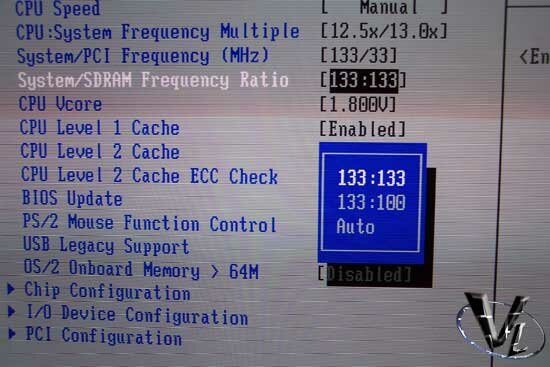|
Written By:
Date Posted: April 1, 2002
The BIOS

Although the A7V266-E uses an AwardBIOS, it differs from the reference version, as it uses the Pheonix BIOS interface that most OEMs use. As we look deeper though, many of our AwardBIOS favorites are still present.

Overclockers will be happy that your multiplier options are quite extensive, so long as your multiplier on the CPU is unlocked. You also have the ability to make changes to the voltage, but alas, you're stuck doing this by jumpers. I should add that this only applies to the DDR voltage, as I/O voltage is non adjustable.

If multiplier adjustments are not in your future, you have a lot of FSB adjustments to choose from. It even lists the corresponding PCI speed, so that you know how much you're pushing the interface. The problem here though, is that there is no PCI adjustment. As you can see in the picture, at 165, the PCI is running at 41. Hardly a problem, but if by some miracle you can hit the 200+ range, your PCI slots will be running at 50+.

Luckily, even with extreme overclocking, you can still set your memory speed independently. Because overclocking is not a complete science, having various options to attain stability is a definite plus.

Delving deeper into the BIOS, you have the usual options of adjusting memory timings, and AGP features.

We only had onboard audio, and since we already had a sound card, this was disabled.

Like any ACPI compliant motherboard, you can adjust how you want power saving to work. More importantly, you can keep an eye on your fans and CPU temperature from the BIOS. Why is this important? I find that the CPU works harder when it's not in Windows, which uses HLT to slow down the CPU when idle, and this will give a better indication if your cooling is up to spec. I should add that the CPU temps always hovered in the 50C range, regardless of the CPU. Granted, we only tested with the XP 1800+, and the XP 2000+.
Although the XP thermal diode isn't used, you do have access to the CPU Overheat Protection offered by Asus. It's not designed to protect your CPU if your heatsink falls off, but if your CPU gets too hot, it will throttle itself to a lower speed. At what temperature is up to you, as you have quite a bit of flexability here.

Being a RAID junkie, the first thing I did was to set it up. The interface is very easy to use, but I do wish it allowed for more user intervention.

For you fast boot up freaks, one annoying feature of the Promise RAID is that the bootup takes a long time. Be prepared to wait three to five seconds, which is an eternity in computer time.

I am afraid that even if you choose not to use the RAID controllers, you cannot disable it. This differs from the integrated HighPoint controller other manufacturers choose, as you can disable it. Because of this, even with a screaming CPU, POST, and pre-Windows load times can be as long as 10 seconds.
Previous Page - More Goodies
Next Page - Overclocking and Test Setup
|


